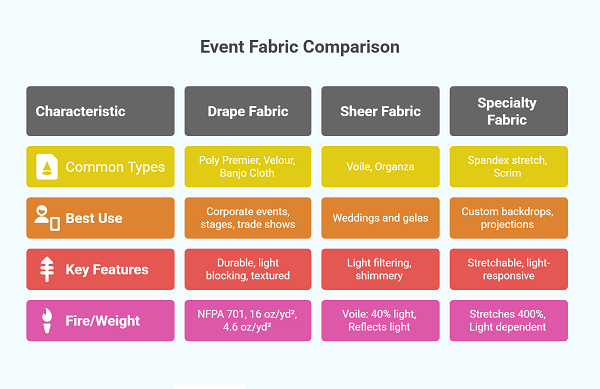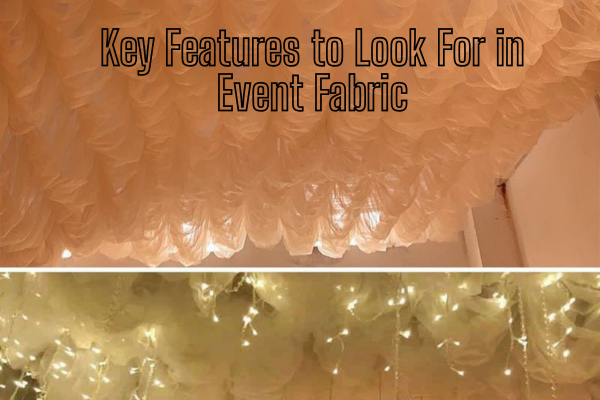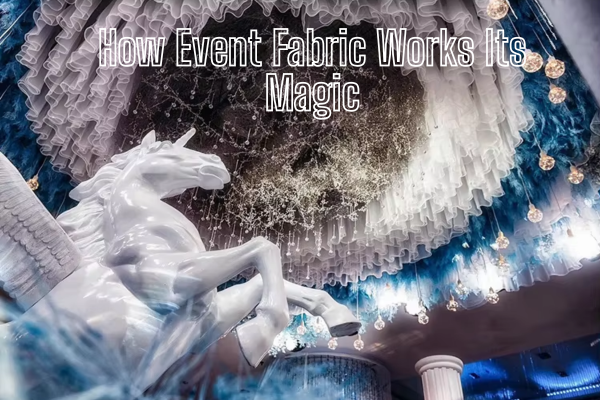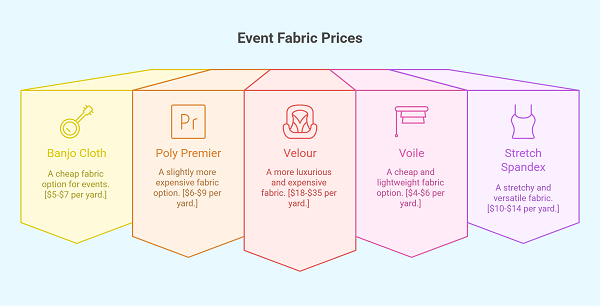What Is Event Fabric?
Let’s face it—no one walks into a trade show, wedding, or awards gala and says, “Wow, look at that pipe and drape system!” But they should. Because behind every stunning event setup, there’s one secret weapon: event fabric.
This isn’t just cloth. It’s the backbone of ambiance. It hides ugly walls, controls acoustics, and turns boring rooms into showstoppers.
Table of Contents
Types of Event Fabric You’ll Actually Use
Let’s stop pretending all fabric is created equal. It’s not. Here’s what matters in the event world.

Drape Fabric – The Curtain Call
This is your go-to. Common types?
- Poly Premier – Durable, low-sheen. Used in 80% of corporate events.
- Velour – Heavyweight. Blocks light and sound. Perfect for stages.
- Banjo Cloth – Textured. Affordable. Classic trade show booth look.
Want numbers? Poly Premier fire rating: NFPA 701 compliant. Velour weight: 16 oz/yd². Banjo? Just 4.6 oz/yd²—light and budget-friendly.
Sheer Event Fabric – Because Mood Matters
Whispers of elegance. Used in weddings and galas.
- Voile – Ultra-light. Filters light beautifully.
- Organza – Shimmery. Great for ceiling swags.
Voile lets in up to 40% of ambient light. Organza? Reflects light from chandeliers like a dream.
Specialty Backdrops and Projection Fabrics
These aren’t just backdrops. They’re tech-savvy.
- Spandex stretch fabric – Custom shapes. Wrinkle-resistant.
- Scrim – Transparent or opaque based on lighting.
Spandex stretches up to 400% of its original size. Scrim can disappear or reveal based on how it’s lit. Magic? Almost.
Key Features to Look For in Event Fabric

Let’s not sugarcoat it. Choosing the wrong fabric can wreck your event. Here’s what matters most.
Fire Retardancy—No Exceptions
If it’s not certified, it doesn’t belong in your venue. Period.
- Look for NFPA 701, CA Title 19, or BS 5867 certifications.
- 93% of indoor event venues require flame-retardant fabrics.
Don’t assume. Always check the tag or ask the supplier.
Durability and Reusability
Think long-term. One-time use is wasteful—and expensive.
- Heavyweight polyester can last through 20+ setups.
- Spandex and stretch fabrics survive rough handling without pilling
- If you’re planning five events this quarter, investing in reusable event fabric saves serious money.
Colorfastness and Dye Quality
Nobody wants purple hands after setting up. Trust me, been there.
- Good-quality fabric won’t bleed or fade after a wash or a hot spotlight session
- Check colorfast ratings: Grade 4 or above means minimal fading.
Where and How Event Fabric Works Its Magic

Event fabric does more than drape walls. Let’s break it down.
Trade Shows and Corporate Setups
Think pipe-and-drape, banners, and branded backdrops. Banjo and Poly Premier rule here.
- 85% of exhibition booths use some form of event draping.
- Drape height typically ranges from 8 to 12 feet.
Weddings and Luxury Events
Dreamy ceiling drapes? Sheers. Ceremony arches? Spandex. Aisle runners? Poly blends.
- Draping ceilings increases perceived venue height by 20–40%
- 7 out of 10 luxury weddings use voile or chiffon ceiling treatments.
Stage Setups and Concerts
Enter: Velour. This heavyweight fabric absorbs sound and light.
- Sound absorption coefficient: up to 0.73 at mid-frequency for 16 oz velour.
- Ideal for reducing echo in large halls.
Projection Mapping and Special Effects
Theaters and immersive experiences love projection-friendly fabrics.
- Stretch fabric = futuristic 3D visuals.
- Rear projection fabric = crystal-clear images for 200+ audience size.
Sourcing and Cost—Don’t Get Overcharged
Here’s where people get burned. Event fabric isn’t cheap—but it shouldn’t break you either.

Price Guide (Average per yard)
| Fabric Type | Price Range (USD/yard) |
| Banjo Cloth | $5 – $7 |
| Poly Premier | $6 – $9 |
| Velour | $18 – $35 |
| Voile | $4 – $6 |
| Stretch Spandex | $10 – $14 |
Prices vary by flame retardancy, dye quality, and width (common widths: 60″, 72″, 120″).
Where to Buy
- Online Retailers: RoseBrand, Georgia Stage, Drape Kings
- Rental Services: Good for one-offs. Saves on storage and cleaning.
Pro Tips for Buying Smart
- Ask for swatches before buying in bulk.
- Confirm fire certification before the venue asks.
- Avoid pre-sewn panels if custom sizing matters.
Eco-Friendly Event Fabric: Is It a Thing?
Yes, it’s 2025. Sustainable fabric isn’t just a buzzword.
- Recycled polyester drape options now available.
- Biodegradable voiles gaining popularity.
Events produce over 600,000 tons of waste yearly. Switching to sustainable event fabric? Small step, big impact.
Final Thoughts – Why Event Fabric Deserves More Credit
So there it is. Event fabric does more than look pretty—it builds atmosphere, improves acoustics, and saves the day when walls get ugly. Whether you’re planning a wedding, trade show, or corporate seminar, the right fabric isn’t just a detail—it’s the foundation.
Take a moment to thank the drapes next time. They’re doing more work than you think.
FAQs: Your Event Fabric Questions—Answered
1. What is the most affordable event fabric?
Banjo cloth is the budget king. Durable, fire-retardant, and under $7/yard.
2. Can I wash event fabric at home?
Depends. Poly blends? Yes. Velour? Dry clean only. Always check the label.
3. What size fabric do I need for a 10×10 booth?
At least 11 feet of height coverage. That’s roughly 12 yards of fabric with pleating.
4. Is all event fabric flame retardant?
No! Only certified fabric is. Always ask for proof before using it in venues.
5. Can I reuse event fabric for different themes?
Absolutely. Neutral tones like white, black, and navy work across all event types
